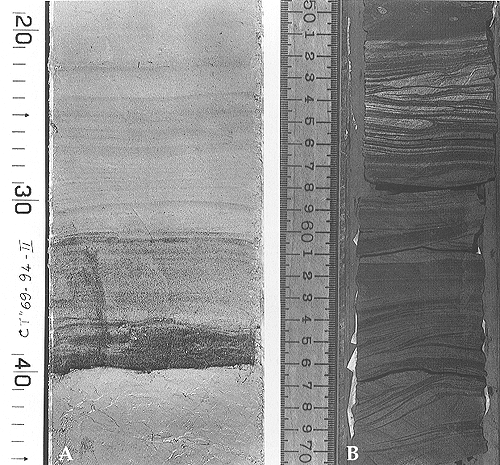
Normal grading
Plate 68

Normal grading
Plate 68
Two sediment cores are here contrasted to show the difference between traction-plus -fallout and traction alternating with fallout. In the first case (A), sand was in suspension with mud, and both were deposited by a turbidity current. There is a small time lag between deposition of coarser and finer materials, owing to hydraulic sorting during fallout, but they are part of the same event. This is testified by the gradual transition from sand to mud, which contrasts dramatically with the sharp, probably erosional base. The sand itself is slightly graded. Vertical grading is called normal when grain size decreases upward. It is the best indicator of fallout from a water column. The sharp base and the presence of tractive laminae in the sand provide additional evidence that fallout did not occur in calm water but from a current. In other words, the association of grading and current structures tells us that deposition occurred from a moving, turbulent suspension.
Turbulence is necessary to keep the particles suspended during transport. Coarser and heavier particles need stronger eddies to support them, so when the current looses energy they are deposited first. Finer particles stay longer in suspension and settle after the passage of the current tail. As it is clear that deposition started abruptly in this case, and was attended by waning energy, we are dealing with a catastrophic event.
The turbidite rests on a fine, pelagic mud; compare its structureless character with the lamination in the turbidite mud. Laminae in muddy sediments do not reflect traction, but small changes in settling rate or other local variations (in turbulence, or particle concentration) within the turbulent cloud.
The the second core (B) is another example of heterolithic facies, of probable tidal origin, similar to those already described and discussed in plates 60 and 61. Tractive and fallout deposits are spatially separated and form distinct beds; tractive structures, represented by cross-laminae and ripple profiles, are obviously found only in sand beds.
| Photos: A Institute for Marine Geology, C.N.R. 1992; B A. Bosellini 1972. |